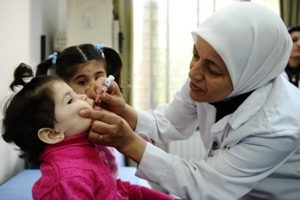Over 20 million children to be vaccinated in Syria and neighbouring countries against polio
A week after the Middle East declared a polio emergency in the region, mass vaccination against polio and other vaccine-preventable diseases under way

Geneva, New York, 8 November – The largest-ever consolidated immunization response in the Middle East is under way to stop a polio outbreak, aiming to vaccinate over 20 million children in seven countries and territories repeatedly.
Emergency immunization campaigns in and around Syria to prevent transmission of polio and other preventable diseases have vaccinated more than 650,000 children in Syria, including 116,000 in the highly-contested north-east Deir-ez-Zor province where the polio outbreak was confirmed a week ago.
In a region that had not seen polio for nearly a decade, in the last 12 months poliovirus has been detected in sewage samples from Egypt, Israel, the West Bank and Gaza Strip. The outbreak of paralytic polio among children in Syria has catalysed the current mass response. The first polio outbreak in the country since 1999, it has so far left 10 children paralyzed, and poses a risk of paralysis to hundreds of thousands of children across the region. Preliminary evidence indicates that the poliovirus is of Pakistani origin and is similar to the strain detected in Egypt, Israel, the West Bank and Gaza Strip.
Dr. Ala Alwan, the World Health Organization Regional Director for the Eastern Mediterranean noted, “The Middle East has shown exactly the coordinated leadership needed to combat a deadline virus: a consolidated and sustained assault on a vaccine-preventable disease and an extraordinary commitment to a common purpose.”
UNICEF has procured 1.35 billion doses of oral polio vaccine (OPV) to date in 2013 and by the end of the year will have procured up to 1.7 billion doses to meet increased demand. Global supply of OPV was already under constraint with vaccine manufacturers producing at full capacity. The new outbreak in Syria is adding further pressure to the supply but WHO, UNICEF and manufacturers are working to secure sufficient quantities to reach all children.
“The polio outbreak in Syria is not just a tragedy for children; it is an urgent alarm — and a crucial opportunity to reach all under-immunized children wherever they are,” said Peter Crowley, UNICEF’s Chief of Polio. “This should serve as a stark reminder to countries and communities that polio anywhere is a threat to children everywhere.”
The unprecedented response to polio virus circulation in the region includes plans for a six-month sustained effort of intense immunization activity. Equally important is heightened disease surveillance until the global eradication of polio, to find cases which may have been missed in an environment which was until recently polio-free.
Multiple mass immunization efforts are aimed at protecting as many children as possible. Inside Syria, the campaign is targeting 1.6 million children with vaccines against polio, measles, mumps and rubella. In Jordan over 18,800 children under the age of five were vaccinated against polio in a campaign in the past few days targeting all children at Za’atari camp and a nationwide campaign is currently underway to reach 3.5 million people with polio, measles and rubella. In Iraq, a vaccination campaign has started in the west of the country, with another campaign planned in the Kurdistan Region in the coming days. Lebanon’s nationwide campaign begins later this week and Turkey and Egypt by mid-November.
The seven countries and territories in the consolidated emergency response to the polio outbreak are: Egypt, Iraq, Jordan, Lebanon, the West Bank and Gaza, Syria, Turkey.
Since 1988, vaccination has reduced polio by more than 99% worldwide, and the disease is slated for complete eradication. Only three countries remain which have never stopped polio: Pakistan, Nigeria and Afghanistan. As long as polio is endemic anywhere, outbreaks remain a risk. The Polio Eradication and Endgame Strategic Plan focuses on stopping polio in the remaining endemic areas, but also accounts for outbreaks, including in areas of insecurity, and prepares for an effective emergency response.
The polio virus usually infects children in unsanitary conditions through faecal-oral transmission associated with close person to person contact and consumption of food and drink contaminated with faeces. It attacks the nerves and can kill or paralyse, spreading widely and unnoticed before it starts crippling children. For every one case of polio, 200 children can be infected. There is no cure for polio – it can only be prevented through immunization.












